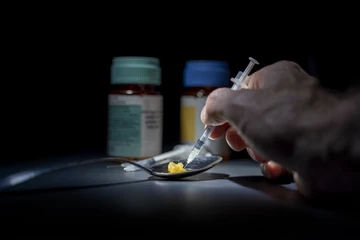
The Power of Hemp: Unleashing the Potential of Hemp Seed Oil for Hair
Most people only know hemp for its calming and relaxing benefits, but it is not limited to this. Whether taking

The above is a dialogue from a movie done by Johnny Depp, a famous Hollywood actor. But in this case, the problem is not the problem. The problem is the solution to the problem — a bigger problem than anticipated.
Pain is one of the most common ailments that we know. We all have experienced some form of pain in our lives. It is quite likely that whosoever is reading has body pain or knows someone who has it. As I am writing this article, I am struggling with shoulder pain because I slept on the wrong side of the bed. However, this publication is not about any pain but specifically about chronic pain.
Chronic pain is unlike a temporary physical pain we witness when we have a stubbed toe, a toothache, a sore throat, etc. The pain signal stays in the nervous system for days to months to years. The different types of chronic pain are pain caused by arthritis, migraine, fibromyalgia, damage to the nervous system, and others. The person ends up suffering for a prolonged period. The quality of life is compromised due to the frustration this pain causes.
In India, there are more than 180 million chronic pain patients. This disease is prevalent across the globe. Around 100 million people in Europe are living with chronic pain problems. 20.4% of the total adult population of the United States Of America (U.S.A) suffers from chronic pain. It constitutes a population size of 50 million adults. A total of 8% (19.6 million) of the adult population suffers from high-impact chronic pain.
To quantify the aftermaths in the U.S.A, around 149 million annual workdays are getting lost due to chronic back pain. After heart and pulmonary disease, chronic pain is the third most troublesome disease in the U.S.A.The repercussions of chronic pain have burdened an additional cost of 100 to 200 million annually.
Multiple treatments are available for chronic pain. The cure varies and depends on the type of chronic pain. Treatment includes medication (opioid and non-opioid based), behavioral health approaches, and physical therapies based approaches. Effectiveness, affordability, and accessibility are challenges for behavioral and physical approaches. Non-opioid medicines can have severe side effects. For example, Acetaminophen can lead to liver injury. Opioid derived medications, such as Morphine, Fentanyl, Hydromorphone, Methadone, Oxycodone, and others, have proven effective in the treatment. The caveat is opioids are adhesive.

The bigger problem — Opioid use disorder and Heroin
Opioid refers to natural and synthetic substances that act at one of the three main opioid receptor systems (mu, kappa, delta). Opioids can act as pain relievers; they have central nervous system depressant effects and the potential to cause euphoria. Opioid use disorder is a consequential adherence to opioids. Opioid use disorder gets triggered by consuming a significant amount of opioids than needed or using opioids for a period longer than intended. The person suffering from it is unable to curb the craving for using opioids. The disorder hinders in fulfilling obligations at work, home, or school. In some cases, opioid overdose has even been a reason for death.
In India, there are 1 million opioid-dependent people. According to a study, 1 out of 4 people who have used opioids are dependent on it. Punjab, a state in India, has 232,00 people who rely on opioids. In 2016, there were 2.1 million people with opioid use disorder in the United States of America.
The National Institute on Drug Abuse has worrisome opioid crisis statistics. Around 21–29% of the patients with prescribed opioids for pain, end up misusing them. Nearly around 8–12% of the patients develop opioid use disorder. Since heroin is often cheaper than prescription opioids, 4–6% of people start using heroin. About 80% of people who use heroin have misused prescription opioids earlier.
Heroin is an extremely addictive substance. It is a derivative of morphine, and it is an opioid most commonly abused through injection. According to a study by the National Survey on Drug Use and Health, from 2002 to 2013, heroin-related overdose death has increased by 286% in the U.S.A. Opioids were involved in 47,600 deaths caused by overdose in 2017, contributing to 68% of all drug overdose cases.
Cannabis medicines for chronic pain
The quest for effective and non-addictive medication to treat chronic pain ends at cannabis-derived medicines. CBD (Cannabidiol) and THC (Tetrahydrocannabinol) are two naturally occurring chemical compounds found in the cannabis plant with therapeutic abilities. These compounds work with the endocannabinoid system of the body and help to promote the overall well being of the body. This entire process is called homeostasis.Both compounds have proven effective in treating chronic pain. A study indicated that 62% of medical cannabis patients use cannabis for pain management.

Over a while, multiple studies have validated the effectiveness of cannabis for chronic pain. According to a study published in the Canadian Agency for Drugs and Technologies in Health, cannabis-based medicines are an option for treating patients with neuropathic pain, chronic non-cancer pain, and chronic non-cancer, non-neuropathic pain. In India, there are multiple cannabis medicines available online for treating pain.
The National Institute on Drug Abuse has worrisome opioid crisis statistics. Around 21–29% of the patients with prescribed opioids for pain, end up misusing them. Nearly around 8–12% of the patients develop opioid use disorder. Since heroin is often cheaper than prescription opioids, 4–6% of people start using heroin. About 80% of people who use heroin have misused prescription opioids earlier.
Heroin is an extremely addictive substance. It is a derivative of morphine, and it is an opioid most commonly abused through injection. According to a study by the National Survey on Drug Use and Health, from 2002 to 2013, heroin-related overdose death has increased by 286% in the U.S.A. Opioids were involved in 47,600 deaths caused by overdose in 2017, contributing to 68% of all drug overdose cases.
Chronic pain is a challenge that will continue to exist. At the same time, using medications with minimum or no side-effect is the real challenge. Replacing opioids with cannabis will offer an addiction-free pain relief medication to patients. It will also cut down the abuse of opioids by people dependent on it. Cannabis medicines are a safer and effective alternative to adhesive opioids.
Disclaimer: The above publication is for educational purposes only by collating information from various sources.
Resources:
The Prevalence of Chronic Pain among Adults in India [Link]
Pain alliance Europe [Link]
Prevalence of Chronic Pain and High-Impact Chronic Pain Among Adults — United States, 2016 [Link]
What are opioids [Link]
Research on opioid substitution therapy in India: A brief, narrative review [Link]
Opioid Use Disorder [Link]
Opioid Overdose Crisis [Link]
The Laboratory’s Role in the Opioid Crisis [Link]
Observational Analyses of Cannabis Substitution Among Medical Cannabis Users With Chronic Pain [Link]
Effect of cannabis use in people with chronic non-cancer pain prescribed opioids: findings from a 4-year prospective cohort study [Link]
Medical Cannabis for the Treatment of Chronic Pain: A Review of Clinical Effectiveness and Guidelines [Link]

Most people only know hemp for its calming and relaxing benefits, but it is not limited to this. Whether taking

When it comes to haircare, the beauty industry is no stranger to new trends and innovative ingredients. However, one ingredient

Post Covid-19 pandemic, online shopping has become the businesses’ and consumers’ lifeline. From groceries to clothes and electronics to medicine,
Contact Us
Call: +91 - 9916200141
Registered Office: Burudhukunte Road, #16, Saiven Caesars Palace, Sarjapura Hobli, Bangalore, Karnataka, 562125
Information
© 2021 by Happie Hemp Private Limited